In the Bazaars of Hyderabad
"In The Bazaars of Hyderabad" is an early 20th-century English poem written by Sarojini Naidu (1879–1949) (also known as The Nightingale of India), an Indian independence activist and a poet from Hyderabad, India. The poem is written in five stanzas, was first published in the year 1912 from London in a form of book The Bird of Time with her other series of poems. The poem typifies the social and the cultural life of Hyderabad, it is not only meant for financial dealing for buying and selling, but it is also a meeting place for people from different background having multifarious interest.
| by Sarojini Naidu | |
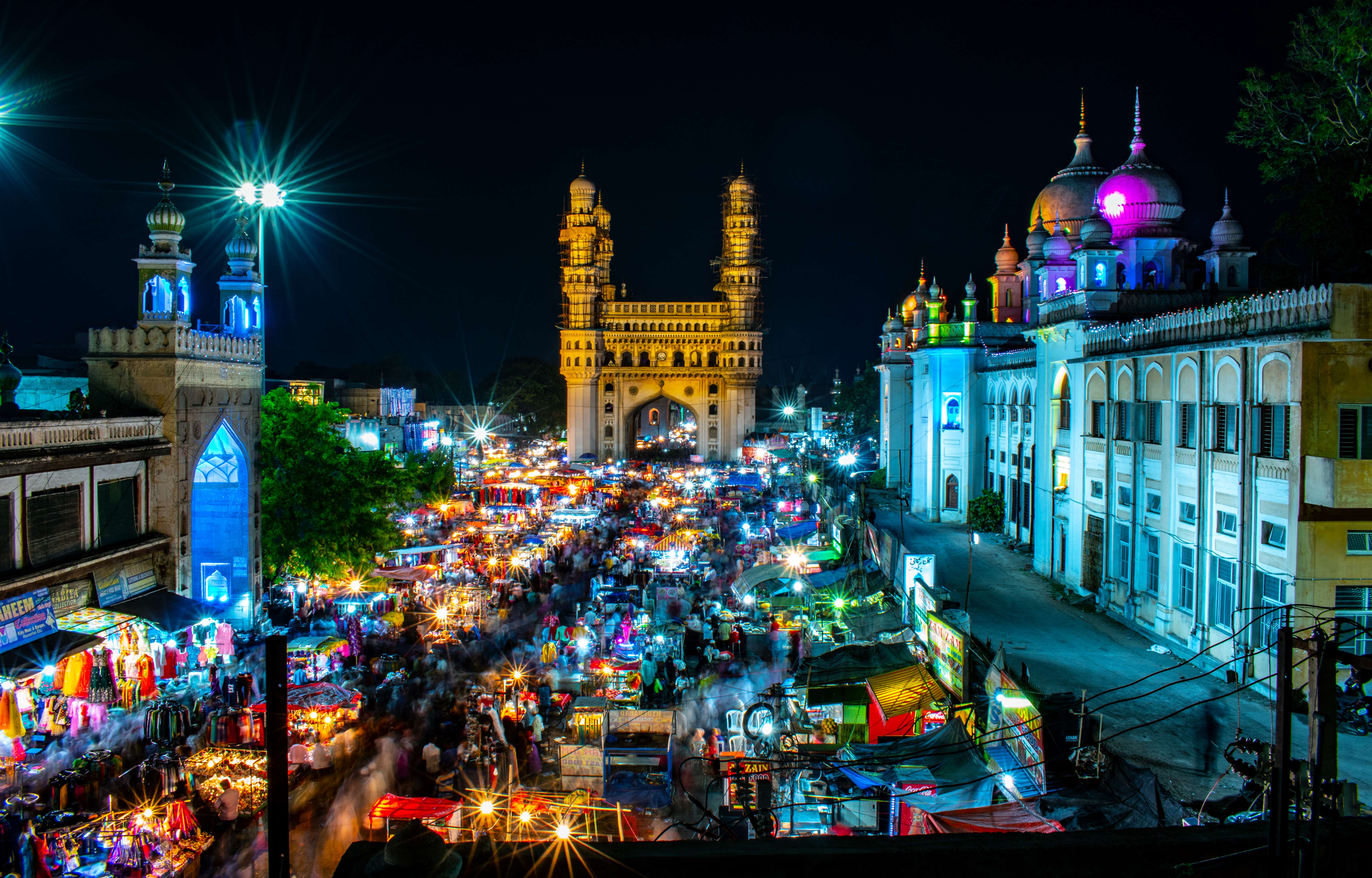 in the Bazzars of Hyderabad | |
| Country | India |
|---|---|
| Language | English and Hindustani |
| Publication date | 1912 |
In this poem Naidu describes the beauty of traditional Hyderabadi Bazaars. She presented the lively pictorial scenes of merchants, vendors, peddlers, goldsmiths, fruit-men and flower girls selling their goods, all of whom answer the questions of purchasers who buy their articles after a detailed bargaining. The poem also describes the musical instruments being used by the musicians and magicians described in the bazaar.
Most of the Boards of Education in India and some universities of Europe include the poem in the English literature syllabus. Schools in India promote pupils to perform skits on the poem to make them understand the Bazaar's scenario in earlier days.
About the cityBold text
The city of Hyderabad had a mixed culture of the Hindu and the Islamic. The goods sold by the Bazaar vendors (i.e. the merchants, vendors, maidens, peddlers, goldsmiths, fruit-men, musicians and flower-girls) cater to the need of every segment and faith of the society. The poet provides a panoramic view of the colours, sounds, smell and sights of an Indian Bazaar. She has also used vibrant rhymes to describe the magnificence of the bazaars and also the products sold in the bazaars. '
Style
In this poem Sarojini Naidu describes the magnificent things of life along with common scenes in the bazaars of Hyderabad; The poem is set in the form of conversations between customers and vendors. Naidu has repeatedly asked questions in every stanza about the different kinds of goods sold in the bazaar.[1] Naidu presents the scene of the music produced by traditional instruments played by the musicians and the chantings of the magicians, the various fruits being sold by the fruit-men, the weighing of saffron, lentils and rice by the vendors, and other depictions of different wares which are sold in the bazaar. The poet has used vibrant rhymes to describe the magnificence of the bazaars and the products sold.[2][3]
Poetic devices
Each line of the poem contains a rhythm and a beat, and the sequence of the phrases "What do you" and "O ye" marks the rhyme scheme of the poem. The poetess often repeats these phrases, to create a musical effect, to emphasise a point, and to lend unity to the poem. The conversation form of poem, that is set in the form of question and answer between vendor and buyer, makes the readers feel that they are present in the Bazaar. To present the pictorial scene of the bazaar, Naidu uses rich sensory images and a vibrant sense of touch, sound, smell, sight and taste.[4][5][6][7]
Themes
Folklore is one of the central subject in the poetry of Naidu. In The Bazaars of Hyderabad is associated with one such subject, the charm and enthusiasm of a traditional Indian bazaar in the city of Hyderabad is presented in this poem. Naidu had enthusiastically described the Bazaar with merchants and vendors selling diverse range of wares. The poet stops over at the galleries arranged by the merchants, traders, hawkers, goldsmiths, fruit sellers, peddlers,magicians,musicians and flower girls. The poet describes the experience of conversation between the seller and the buyer, here the poet questions the sellers about what they are selling and who in turn answer politely, explaining their products. Emotional moods are stirred by the poet, when Naidu makes the readers feel that the bazaar life also witnesses both sorrows and joys. Wedding and festival occasions brings joy in the Bazaar’s life when people buy jewellery, garlands, fruits and children crowding near the magicians. The sorrow and sadness is witnessed when common public kitchens are arranged when the nobles or soldiers die and when flower girls are seen weaving masses of white flowers to be used for the dead people’s grave.[4][5][6][7]
Another theme in the poem is the Swadeshi movement, though not specifically mentioned in the poem. The poem was written during the Indian independence movement.By this poem Naidu proves that India is rich in tradition and there is no requirement of foreign products. Through the poem, Naidu encourages the Indians to buy goods from their traditional bazaars and she urges the country men to take part in the Swadeshi movement and boycott all foreign goods.[8][9]
Text
The text of the poem is as follows.[10][11][12]
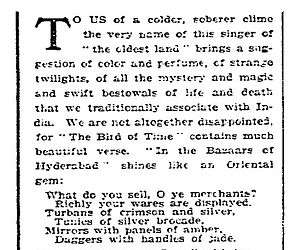

- In The Bazaars of Hyderabad
- What do you sell, O merchants?
- Richly your wares are displayed.
- Turbans of crimson and silver,
- Tunics of purple brocade,
- Mirrors with panels of amber,
- Daggers with handles of jade.
- What do you weigh, O ye vendors?
- Saffron, lentil and rice.
- What do you grind, O ye maidens?
- Sandalwood, henna and spice.
- What do you call, O ye pedlars?
- Chessmen and ivory dice.
- What do you make, O ye goldsmiths?
- Wristlet and anklet and ring,
- Bells for the feet of blue pigeons,
- Frail as a dragon-fly's wing,
- Girdles of gold for the dancers,
- Scabbards of gold for the kings.
- What do you cry, O ye fruitmen?
- Citron, pomegranate and plum.
- What do you play, O musicians?
- Sitar, Sarangi and drum.
- What do you chant, O magicians?
- Spells for the aeons to come.
- What do you weave, O ye flower-girls?
- With tassels of azure and red?
- Crowns for the brow of a bridegroom,
- Chaplets to garland his bed,
- Sheets of white blossoms new-garnered
- To perfume the sleep of the dead.
--Sarojini Naidu--
Summary
The poet talks about the product offered in the old bazaars of Hyderabad. In first stanza of the poem, the poet questions the merchants in the bazaar about what they are selling, to which the merchants answered that they are selling crimson, silver coloured turbans, mirrors with drawers of amber [an expensive Indian stone] and daggers with handles made of jade.
In the second stanza, the poet moves to another stall and asked the same question to the vendor about what they are weighing to sell. Saffron, lentils and rice replied the vendors. The poet asks the same question to maidens about what they are grinding and she gets a reply that they are grinding henna, sandalwood and spices. In the end of the stanza, the poet questions the peddlers about what they are selling and they reply dice made from ivory and chessmen.
The poet moves to a jewellery shop in the third stanza and asks the goldsmith what ornaments they manufacture. They reply; necklace, bracelets, anklets, rings, and continued to say that, they also make bells for blue pigeons that are tied to their feet. The bells are as delicate as a dragonfly's wing. Simultaneously they make gold girdles for dancers and scabbards for the kings to keep their swords.
In the fourth stanza, the poet visits a fruit shop. There she inquires about what they are selling. They reply that they sell lemon, pomegranate and plum. Then the musicians were asked what they play and they say sitar, sarangi and drums. The poet even comes across magicians and asks them what they are chanting and they say that they are chanting magical spells to charm thousand ages to come.
The final stanza is about the flower girls who are asked what they are weaving with strands of colourful flowers. The flower girls answer that they are making garlands for the bride and groom to be decorated during the wedding night. Alternately they also weave sheets of white flowers which are placed on graves for fragrance purposes.
Imagery
The poet has used vibrant senses of the human body to describe the majesty of the Hyderabadi traditional bazaar. Visual depiction is described by the use of lively colours such as silver, crimson, purple, amber, blue, azure, red and white. Aural depiction is created through the melody of the sitar, the sarangi, the drums and the chanting of the magical spells by the magicians. Olfactory senses are stimulated through the use of the fragrances describing sandalwood, henna and the smell of flowers. Gustatory depiction is created through the portrayal of the fruits like lemons, pomegranates, plums and principal Hyderabad food such as lentils and rice. In the last, the palpable imagery is produced by the bells made for the pigeons.[4][5][6][7]
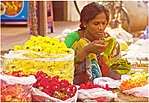 A flower vendor in the bazaars of Hyderabad
A flower vendor in the bazaars of Hyderabad- An itar (perfume) vendor in the Bazaars of Hyderabad
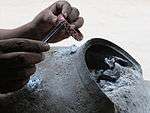 A bangle maker studding artificial diamonds in the heated Lacquer bangle.
A bangle maker studding artificial diamonds in the heated Lacquer bangle. A view of the street occupied by vendors from the top of Charminar.
A view of the street occupied by vendors from the top of Charminar.
 A Henna designer in the streets.
A Henna designer in the streets.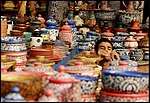 An earthenware clay pots in the Shilparamam—government sponsored handicraft Bazaar.
An earthenware clay pots in the Shilparamam—government sponsored handicraft Bazaar.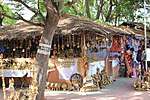 A scene at Shilparamam.
A scene at Shilparamam.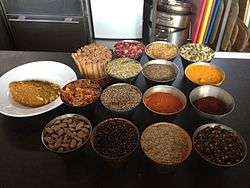 Spices sold in the Bazaars.
Spices sold in the Bazaars.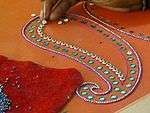 Zari embroidery work on cloth being prepared to be sold.
Zari embroidery work on cloth being prepared to be sold. Bidriware craftman at work.
Bidriware craftman at work.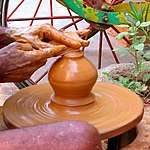 A potter preparing earthenware
A potter preparing earthenware Bidriware craft work on Hooka Water pipe base.
Bidriware craft work on Hooka Water pipe base.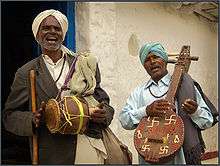 Village musicians in Hyderabad singing and playing a drum and string instrument.
Village musicians in Hyderabad singing and playing a drum and string instrument. Khanjar—also known as Jambia in local slang.
Khanjar—also known as Jambia in local slang.
Popular culture
The poem is included in the syllabus of; Indian Secondary schools, Civil Services Examination and in some of the universities of Europe.[13][14][15] Some schools in India organise a skit base play based on the poem to make their people understand the shopping experience in the bazaars, including the Hyderabadi biryani, the traditional ingredients used in the Hyderabadi cuisines, and the jewellery and clothing.[16] Based on the poem, a play titled "Love's Labour" was conducted in Madurai by the students of Sri Meenakshi college for women. The play was different from regular stage plays as it contained model sets of bazaars similar to Hyderabad. The play was organised to promote the literary work of women.[17]
The New York Times review the poem in the edition of 27 April 1913 and wrote that; "To us of a colder, soberer clime the very name of this singer of "the oldest land" brings a suggestion of color and perfume, of strange twilight's, of all the mystery and magic and swift bestowals of life and death that we traditionally associate with India. We are not altogether disappointed, for "The Bird of Time" contains much beautiful verse. "In the Bazaars of Hyderabad" shines like an oriental gem":[9]
See also
References
- Kundu, Rama; Ray, Mohit Kumar (2005). Studies In Women Writers In English, Volume 3. Atlantic Publishers & Dist. pp. 108–9. ISBN 9788126904358. Retrieved 26 May 2013.
- Kaur, Satvinder (2003). Sarojini Naidn's Poetry. Sarup & Sons. pp. 137–8. ISBN 9788176254281. Retrieved 26 May 2013.
- Naravane, Vishwanath S. (1980). Sarojini Naidu: an introduction to her life, work and poetry. Orient Blackswan. pp. 138–9. ISBN 9788125009313. Retrieved 26 August 2011.
- Anand, Renu; Alurkar, Sudha (1964). Techniques of counseling guidance, counseling and student personnel in education McGraw-Hill series in education. Tata McGraw-Hill Education. pp. 66–70. ISBN 9780070683815. Retrieved 26 May 2013.
- Iyer, N Sharada (1964). Musings on Indian Writing in English: Poetry. Sarup & Sons. p. 150. ISBN 9788176255745. Retrieved 1 July 2013.
- Jagadisan (2001). A thing of beauty. Orient Blackswan. p. 55. ISBN 9788125016250. Retrieved 3 July 2013.
- Ashita, Barot. Perfect Practice Series English Babharati Workbook Std.VIII. pp. 17–20. Retrieved 29 September 2013.
- Sindhu, CH (February 2013). "The Indian spirit in the poems of Sarojini Naidu" (PDF). English Literature. Research Link. XI (12): 45–7. ISSN 0973-1628. Archived from the original (PDF) on 3 October 2013. Retrieved 24 July 2013.
- Helen, Bullis (27 April 1913). "Poet of India" (PDF). The New York Times. Retrieved 29 September 2013.
- "In The Bazaars of Hyderabad". English for students. Retrieved 26 August 2011.
- Daruwalla, Keki N (2005). Poetry Magic 8. Ratna Sagar. pp. 15–16. ISBN 9788183321778. Retrieved 26 August 2011.
- "In the Bazaars of Hyderabad". Indian Institutes of Information Technology. Retrieved 29 September 2013.
- "Alternative English" (PDF). Tripura public service commission. p. 4. Retrieved 29 September 2013.
- "Principals unite to learn lessons from other boards". The Times of India. 11 September 2008. Retrieved 29 September 2013.
- Weber, Joseph Aloysius (2013). "The time has come: Poetry and drama use in the geography class". Yale University. Retrieved 30 September 2013.
- "Skit on The Bazaars of Hyderabad". The Hindu. 4 September 2012. Retrieved 3 July 2013.
- Meyyammai, AR. (23 February 2002). "Spirit of woman recreated". The Hindu. Retrieved 3 July 2013.